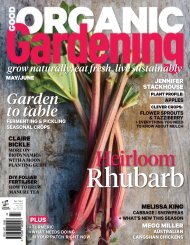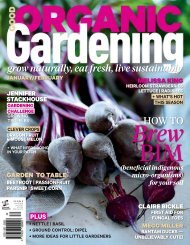6. Good Organic Gardening - November-December 2016 AvxHome.in
6. Good Organic Gardening - November-December 2016 AvxHome.in
6. Good Organic Gardening - November-December 2016 AvxHome.in
You also want an ePaper? Increase the reach of your titles
YUMPU automatically turns print PDFs into web optimized ePapers that Google loves.
PLANT PROFILE | Capsicum<br />
— but some, like the green or red bull’s horn<br />
and the tapered ‘Cubanelle’, which varies from<br />
yellow-green to a shock<strong>in</strong>g fuchsia hue, are<br />
elongated and curved.<br />
Generally speak<strong>in</strong>g, the warmer the<br />
colour (and the more mature the fruit),<br />
the sweeter the flavour. To add yet<br />
another note of confusion, sweet, red<br />
capsicums are actually v<strong>in</strong>e-ripened green<br />
peppers, though there is a variety called<br />
‘Permagreen’ which, not surpris<strong>in</strong>gly,<br />
rema<strong>in</strong>s green when fully ripe.<br />
‘Sweet Mama’ is a modern variety with a<br />
heavy crop of green, bell-shaped fruit that<br />
turns sweet and red, while ‘Sweet Red’ is a<br />
compact variant for the patio pot. ‘Hungarian<br />
Sweet Yellow’, also known as ‘Sweet Banana’<br />
or ‘Yellow Wax’, has long pods that vary from<br />
lemon-yellow to gold.<br />
Among the heirlooms are the classic<br />
‘Ch<strong>in</strong>ese Giant’, with large, red, bell-shaped<br />
fruit, and ‘Purple Beauty’, the colour of<br />
eggplant. ‘White Diamond’ has strik<strong>in</strong>g<br />
translucent fruit that ripens to a creamy<br />
yellow, while ‘Gilboa Orange’ and ‘Sweet<br />
Chocolate’ add even more colour to a salad<br />
or stir-fry.<br />
‘Purple Beauty’<br />
White, green and<br />
chocolate capsicums<br />
from Diggers Club<br />
The redder the sweeter<br />
Long varieties <strong>in</strong>clude<br />
‘Hungarian Yellow Wax’<br />
Grow<strong>in</strong>g<br />
As their Central and South American orig<strong>in</strong>s<br />
might suggest, capsicums like it hot. They<br />
are frost-sensitive, so they do best <strong>in</strong> a cooler<br />
climate when planted <strong>in</strong> spr<strong>in</strong>g. If it’s cold where<br />
you live, the seeds will benefit from hothouse<br />
germ<strong>in</strong>ation but, <strong>in</strong> tropical and subtropical<br />
climes, capsicums are true perennials.<br />
Choose a sunny spot, dig <strong>in</strong> some organic<br />
matter and rotted manure before plant<strong>in</strong>g<br />
and perhaps add a bit of dolomite lime, as<br />
capsicums enjoy good levels of calcium. Feed<br />
through the grow<strong>in</strong>g season with an organic<br />
fertiliser that has the right balance of nitrogen<br />
for leafy growth and phosphorous and<br />
potassium for roots and fruit.<br />
It’s a good idea to stake seedl<strong>in</strong>gs as the<br />
branches of the mature plant can split or snap<br />
with the weight of a ripen<strong>in</strong>g crop. For the<br />
same reason, harvest with secateurs rather<br />
than handpick<strong>in</strong>g, which tends to break the<br />
brittle branches.<br />
Nutrition<br />
Capsicums are a rich source of antioxidants<br />
and vitam<strong>in</strong> C. The levels are even higher <strong>in</strong><br />
red peppers, as are the amounts of carotene<br />
and lycopene common to most red, orange<br />
and yellow fruits and vegetables. Though the<br />
jury’s still out on the supposed anti-cancer<br />
benefits of lycopene, both red and green<br />
capsicums are high <strong>in</strong> para-coumaric acid,<br />
whose antioxidant properties have shown<br />
Generally speak<strong>in</strong>g, the warmer the<br />
colour (and the more mature the fruit),<br />
the sweeter the flavour.<br />
beneficial results <strong>in</strong> stomach cancer.<br />
Capsicums also conta<strong>in</strong> small amounts<br />
of calcium, phosphorus, iron, thiam<strong>in</strong>e,<br />
riboflav<strong>in</strong> and niac<strong>in</strong>.<br />
Choose fruit that is firm, glossy, richly<br />
coloured and heavy for its size. Capsicum<br />
can be used raw <strong>in</strong> salads, cooked <strong>in</strong><br />
ratatouille or sautéed, baked, grilled or<br />
steamed <strong>in</strong> various other dishes. It can be<br />
ground <strong>in</strong>to powder as paprika, preserved <strong>in</strong><br />
oil or v<strong>in</strong>egar, or milled <strong>in</strong>to a pesto.<br />
The arrival of Columbus <strong>in</strong> the Americas<br />
might have been bad news for the Aztecs but,<br />
as <strong>in</strong> the case of the tomato, it’s impossible<br />
to imag<strong>in</strong>e European cuis<strong>in</strong>e — or ours —<br />
without the capsicum.<br />
Capsicum label<br />
Common name: Capsicum, bell<br />
pepper, sweet pepper<br />
Botanical name: Capsicum annuum<br />
Family: Solanaceae<br />
Requires: Warm weather; moist soil<br />
(but not too wet)<br />
Dislikes: Frost or any temperature<br />
extremes<br />
Suitable for: Most vegetable<br />
gardens, pots<br />
Habit: Upright shrub with umbrellalike<br />
fruit clusters<br />
Difficulty: Easy<br />
CanStockPhoto<br />
20 | <strong>Good</strong> <strong>Organic</strong> <strong>Garden<strong>in</strong>g</strong>

















